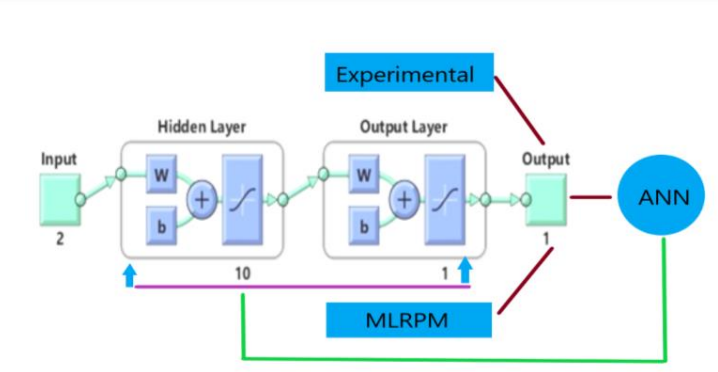Masonry structures have been essential to human civilization for centuries. However, their natural brittleness and sensitivity to tensile forces make them susceptible to failure when subjected to compression and seismic loads. Researchers are consistently investigating new methods to bolster the durability and strength of masonry. One promising technique involves using embedded mesh reinforcement, specifically poultry netting mesh (PNM), within masonry prisms. This mesh-embedded masonry technique incorporates wire mesh into mortar joints to enhance structural stability and resistance to cracking.
A team of researchers published their work in the Journal of Soft Computing in Civil Engineering (2020), examining how various mesh configurations and mortar mixtures impact compressive strength. This article investigates how embedding mesh in masonry influences compressive strength by comparing empirical methods to Artificial Neural Network (ANN) models for predictions. The study focuses on forecasting the compressive strength of brittle materials, particularly masonry, using different models while emphasizing the accuracy and reliability of Artificial Neural Networks (ANN).
It highlights the challenges of predicting masonry strength and the advances made in modelling techniques. Previous works include research on the strength of recycled concrete through deep learning, the effects of material properties on concrete strength, and the successful use of ANN to predict strength under varying conditions, such as the fragility of masonry surfaces during seismic activities. The ultimate goal is to apply statistical analysis and ANN to accurately predict both compressive and flexural strength in masonry construction, thus enhancing the modelling of the intricate relationships involved.
The study involved experiments on 45 specimens using standard brick dimensions of 225 x 105 x 82 mm, with and without PNM embedment. The PNM utilized was a hexagonal shape measuring 28 x 13 mm and 0.3 mm thick. Three mortar mixes were prepared with ratios of 1:3, 1:4, and 1:5 of cement to sand. Variations included both single-layer and double-layer mesh embedments. A consistent mortar thickness of 12 mm was applied, with embedments maintained at the bed joint for both layers. Solid masonry units were cast with a uniform 12 mm mortar thickness. Test specimens were cured with regular water for 28 days. The maximum compressive strength was recorded as a target for statistical analysis and artificial neural network modelling. Compression testing with a Compression Testing Machine (CTM) was conducted until the complete collapse of the masonry prism occurred.
This study advances both statistical and ANN models. The statistical model logically examines quantitative data, summarizing the philosophy behind data collection, organization, representation, and comprehension of acquired information. This research modelled the compressive strength of masonry prisms with an appropriate expression and compared the results to experimental data. A statistical regression equation was created using essential parameters like brick strength, mortar strength, and masonry prism dimensions. The equation included coefficients for mesh embedment and material properties, achieving reasonable predictions that carried a margin of error between 0.4% and 17.3%.
ANN, a subset of artificial intelligence, is noted for its capability to deliver precise predictions in complicated scenarios. The research utilizes MATLAB to train the experimental data via a single-layer perception (SLP), which features a singular weighting function where the weights represent the connection strength. The ANN architecture consists of input, hidden, and output layers, employing sigmoid functions in the intermediate layers. Furthermore, the Back Propagation (BP) method is emphasized as a strategy to improve the training process and correspond with the target data. In particular, for forecasting the compressive strength of masonry prisms, the model integrated two input layers—mesh area and mortar strength—while considering 27 experimental data points, using a Purelin function in the output layer for final predictions.
The results from ANN modelling reveal that the average predictions for compressive strength exhibit a minimal absolute error when compared to the statistical regression equation. Key performance indicators included a mean absolute deviation of 0.22, a mean square error of 0.22, a root mean square error of 0.051, and a mean absolute error of 0.003, indicating that ANN predictions surpassed conventional statistical techniques. The correlation coefficient with experimental outcomes was 0.94.
The results of this study have important implications for civil engineering, especially in regions prone to seismic activity where reinforcing masonry is essential. First, incorporating mesh into masonry enhances its structural performance by boosting resistance to compressive forces, thus lowering the risk of catastrophic failure. Moreover, utilizing artificial neural network (ANN) models improves predictive capabilities, allowing engineers to estimate masonry strength without lengthy physical testing. Finally, using mesh reinforcement may permit the use of lower-strength mortar while preserving overall structural stability, resulting in more economical and sustainable building practices.
Incorporating PNM reinforcement in masonry construction significantly increases compressive strength. Although empirical models give a basic understanding, AI-powered ANN models deliver better accuracy in forecasting performance outcomes. As civil engineering evolves, employing machine learning for structural assessments will be vital for optimizing construction materials and methods.
This research highlights the need to fuse traditional experimental techniques with cutting-edge AI tools to improve the reliability and safety of masonry structures. Future investigations could examine how different mesh materials and configurations affect various structural characteristics, potentially transforming masonry construction methods.
Reference
Kanchidurai, S., Krishnan, P. A., & Baskar, K. (2020). Compressive Strength Estimation of Mesh Embedded Masonry Prism Using Empirical and Neural Network Models. Journal of Soft Computing in Civil Engineering, 4(4), 24-35.doi: 10.22115/scce.2020.228611.1213
Cascardi, A., Micelli, F., & Aiello, M. A. (2016). Analytical model based on artificial neural network for masonry shear walls strengthened with FRM systems. Composites Part B: Engineering, 95, 252-263.doi:10.1016/j.compositesb.2016.03.066.
Zhou, Q., Wang, F., & Zhu, F. (2016). Estimation of compressive strength of hollow concrete masonry prisms using artificial neural networks and adaptive neuro-fuzzy inference systems. Construction and Building Materials, 125, 417-426.doi: 10.1016/j.conbuildmat.2016.08.064


